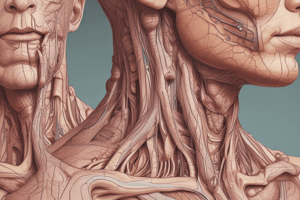Podcast
Questions and Answers
What is the primary function of melanocytes in the epidermis?
What is the primary function of melanocytes in the epidermis?
- Engulf pathogens
- Regulate body temperature
- Absorb UV light (correct)
- Produce keratin
The epidermis is a vascularized layer of the skin.
The epidermis is a vascularized layer of the skin.
False (B)
What is the deepest layer of the skin called?
What is the deepest layer of the skin called?
subcutaneous layer
The epidermis is primarily made of __________ epithelium.
The epidermis is primarily made of __________ epithelium.
Match the following skin cells with their functions:
Match the following skin cells with their functions:
What is the primary function of hair?
What is the primary function of hair?
Basal cell carcinomas are the least common type of skin cancer.
Basal cell carcinomas are the least common type of skin cancer.
What layers make up the hair?
What layers make up the hair?
The ________ is the superficial portion of the hair.
The ________ is the superficial portion of the hair.
Match the following types of skin cancers with their descriptions:
Match the following types of skin cancers with their descriptions:
What does the arrector pili muscle do?
What does the arrector pili muscle do?
Melanin is responsible for the color of human skin.
Melanin is responsible for the color of human skin.
What is the main risk associated with excessive UV exposure?
What is the main risk associated with excessive UV exposure?
What is the primary function of tactile epithelial cells?
What is the primary function of tactile epithelial cells?
The epidermis consists of five strata in most areas of the body.
The epidermis consists of five strata in most areas of the body.
Name the deepest layer of the epidermis.
Name the deepest layer of the epidermis.
The stratum granulosum is characterized by cells that are undergoing _________.
The stratum granulosum is characterized by cells that are undergoing _________.
Which layer of the epidermis is responsible for sealing and providing a boundary between active and dead cells?
Which layer of the epidermis is responsible for sealing and providing a boundary between active and dead cells?
Match the skin layers with their characteristics:
Match the skin layers with their characteristics:
The dermis consists of epithelial tissue.
The dermis consists of epithelial tissue.
What type of tissue makes up the reticular region of the dermis?
What type of tissue makes up the reticular region of the dermis?
Fingerprints are formed by the shape of the ________ papillae.
Fingerprints are formed by the shape of the ________ papillae.
What causes variations in human skin color?
What causes variations in human skin color?
Tattoos fade due to the gradual shedding of skin cells.
Tattoos fade due to the gradual shedding of skin cells.
What enzyme is essential for melanin synthesis?
What enzyme is essential for melanin synthesis?
The ________ region of the dermis is made of areolar connective tissue.
The ________ region of the dermis is made of areolar connective tissue.
How long does it typically take for new epidermal cells from the stratum basale to reach the stratum corneum?
How long does it typically take for new epidermal cells from the stratum basale to reach the stratum corneum?
Melanocytes are present in greater numbers in individuals with dark skin.
Melanocytes are present in greater numbers in individuals with dark skin.
Flashcards are hidden until you start studying
Study Notes
Integumentary System Overview
- Largest organ: 7% of body weight.
- Variable thickness (0.5mm - 4mm).
- Composed of skin, hair, nails, glands, and sensory receptors.
- Functions: temperature regulation, protection, sensation, excretion/absorption, blood/energy storage, vitamin D synthesis.
- Layers: epidermis (avascular), dermis (vascularized), subcutaneous (hypodermis).
Epidermis
- Keratinized stratified squamous epithelium.
- Cell types: keratinocytes (produce keratin and lamellar granules for waterproofing), melanocytes (produce melanin to absorb UV light), Langerhans cells (phagocytic immune cells), tactile epithelial cells (touch receptors).
- Strata (deepest to superficial): basale (stem cells, keratin intermediate filaments), spinosum (strength, thicker keratin), granulosum (dying cells, keratohyalin, lamellar granules), corneum (dead cells, sloughing), lucidum (thick skin only).
- Epidermal growth: 4-6 weeks from basale to corneum. Keratinization reinforces skin.
Dermis
- Connective tissue; high tensile strength.
- Two regions: papillary (areolar connective tissue, dermal papillae, sensory nerves) and reticular (dense irregular connective tissue, resists stretching and shear).
- Contains glands, nerves, blood vessels.
- Anchors dermis to subcutaneous layer.
- Fingerprints formed by dermal papillae shapes and epidermal ridges.
Skin Color
- Melanin production varies; melanocyte number is relatively consistent.
- Tanning results from increased tyrosinase activity (melanin synthesis) due to UV exposure. Tans fade as cells die and are replaced.
- Carotene (orange pigment) also contributes to skin color.
- Tattoos are permanent because ink is deposited in the dermis.
Hair
- Protection, insulation, sensation.
- Located on scalp, eyebrows, eyelashes, etc.
- Structures: root (embedded in dermis/hypodermis), shaft (superficial), medulla (pigmented cells), cortex (bulk of hair), cuticle (outer layer).
- Hair follicle: external epithelial layer, internal matrix (dividing cells for hair growth).
- Associated with arrector pili muscles (hair standing on end).
Nails
- Protection of fingertips and toes.
- Composed of keratinized cells.
Skin Cancer
- Basal cell carcinoma (stratum basale, most common).
- Squamous cell carcinoma (stratum spinosum).
- Malignant melanoma (melanocytes).
Studying That Suits You
Use AI to generate personalized quizzes and flashcards to suit your learning preferences.





